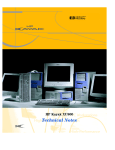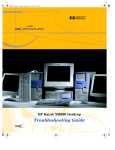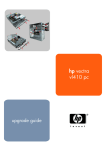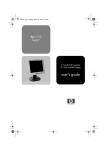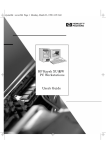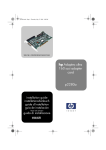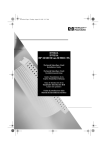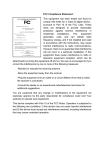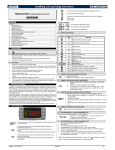Download HP XM600 User's Manual
Transcript
Chapter2.fm Page 1 Wednesday, December 8, 1999 6:13 PM Installing and Replacing Hardware Parts in Your PC Workstation This chapter provides information about installing accessories and replacing hardware parts in your PC Workstation. HP UltraFlow Airflow Guide Power Supply Unit Front Access Drives, for - three 5.25-inch drive shelves - two 3.5-inch shelves including a 1.44 MB floppy disk drive Rear Fan Spare mounting rails (not shown) for: - 3.5-inch (short green) devices (for example, zip drive), - 5.25-inch (long green) devices, - 3.5-inch (short blue) hard disk drives Primary Hard Disk Drive Shelf Secondary Hard Disk Drive Shelf Second 3.5-inch shelf for zip drive or second floppy disk drive Contact your dealer for an up-to-date list of supported devices or check the HP web site: http://www.hp.com/go/kayak. Chapter2.fm Page 2 Wednesday, December 8, 1999 6:13 PM Installing and Replacing Hardware Parts in Your PC Workstation HP Kayak XM600 PC Workstation System Board Depending on the model, the memory module sockets support either: • Two RDRAM modules. Support for one or two processors • Two SDRAM modules installed in a Memory Expansion Card. Up to six accessory cards can be installed: - One Universal AGP PRO (graphics) - Five 32-bit PCI slots Floppy Disk Drive Connector Primary IDE Connector Secondary IDE Connector HP Kayak XU800 PC Workstation System Board Single Memory Expansion Card Connector, supporting either four RIMM sockets or, four DIMM sockets Support for one or two Pentium III processors - PCI 1 slot (32-bits 33 MHz) - PCI 2 slot (32-bits 33 MHz) - PCI 5 slot (32-bits 33 MHz,) Floppy Disk Drive Connector Secondary IDE Connector Primary IDE Connector - PCI 3 slot (64-bits 66 MHz) - PCI 4 slot (64-bits 66 MHz) One Universal AGP PRO slot (graphics) 2 16-bit Internal U160 68-pin SCSI connector VRM socket. Only to be used with second processor Chapter2.fm Page 3 Wednesday, December 8, 1999 6:13 PM Installing and Replacing Hardware Parts in Your PC Workstation Removing and Replacing the Cover and Front Bezel Removing and Replacing the Cover and Front Bezel Removing the Cover For your own safety, it is recommended that you first read the warning notices on in the Introductory Section. 1 Switch off the display and computer. Disconnect all power cables and any LAN or telecommunications cables. 2 Unscrew the two thumb screws located at the back of the PC Workstation. 3 Standing at the back of the PC Workstation, slide the cover towards you until it clicks into place. 4 Tilt the cover sidewards, then lift off the PC Workstation chassis. ➍ Removing the Front Bezel 5 If required, remove the front bezel which is divided into two sections: • The upper bezel (blue) gives access to three 5.25-inch shelves and two 3.5-inch shelves. • The lower bezel (grey) gives access to the control panel. To access the lower bezel, you must first remove the upper bezel. 3 Chapter2.fm Page 4 Wednesday, December 8, 1999 6:13 PM Installing and Replacing Hardware Parts in Your PC Workstation Removing and Replacing the Cover and Front Bezel NOTE Take care when removing the upper and lower bezels. They are not on a hinge, so do not force them open. To remove the upper and lower bezels: a Unclip the two clips located on the left-hand side of the bezel. b Open the bezel slightly, and then gently push it outwards. ➎a ➎b ➎a Replacing the Cover and Front Bezel 1 Ensure that all internal cables are properly connected and safely routed. 2 If necessary, replace the front bezel. To do this, ensure that the bezel is correctly orientated, align the two plastic tabs with their slots on the right-hand side of the chassis, and then close the bezel. If you have removed both sections of the front bezel, first replace the lower bezel. 3 Standing at the back of the PC, lower the cover onto the chassis (aligning the guide rail on the bottom inside edge of the cover with the bottom edge of the PC chassis). 4 Shut the cover ensuring that the guides on the top of the cover slide into the rails at the top of the chassis. 5 Slide the cover forwards, then tighten the two thumbscrews. 6 If required, lock the cover using the key provided. Reconnect all the power and telecommunications cables. 4 Chapter2.fm Page 5 Wednesday, December 8, 1999 6:13 PM Installing and Replacing Hardware Parts in Your PC Workstation Removing and Replacing the Airflow Guide Removing and Replacing the Airflow Guide Removing the HP UltraFlow Airflow Guide Replacing the HP UltraFlow Airflow Guide 1 Switch off the display and PC Workstation. Disconnect all power cables and any LAN or telecommunications cables. 2 Remove the PC Workstation’s cover (refer to page 3). 3 Grasp the handle on top of the HP UltraFlow Airflow Guide, then slide it out of the PC Workstation. 4 Lift the HP UltraFlow Airflow Guide upwards to remove it from the PC Workstation’s case. 1 Slide the HP UltraFlow Airflow Guide onto the processor fan housing until it clicks into place. 2 Replace the PC Workstation’s cover (refer to page 4). Reconnect all the power and telecommunications cables. 5 Chapter2.fm Page 6 Wednesday, December 8, 1999 6:13 PM Installing and Replacing Hardware Parts in Your PC Workstation Removing and Replacing a Processor Removing and Replacing a Processor Single-processor systems can be upgraded to dual-processor systems by installing a second processor in the vacant processor slot. The second processor must be of the same type, speed and level-2 cache memory capacity as the first. 1 Switch off the display and PC Workstation. Disconnect all power cables and any LAN or telecommunications cables. 2 Remove the PC Workstation’s cover (refer to page 3 for instructions). 3 Remove the HP UltraFlow Airflow Guide (refer to page 5). 4 If you intend to: 6 a Remove a Processor: Press the retention clips on both sides of the processor outwards. Then gently lift the processor upwards from the processor connector, taking care not to tilt it too much. b Install a Second Processor: Remove the processor terminator from the CPU 2 connector. Store the terminator in a safe place. For information about upgrading the operating system, refer to "HP DualExpress!", on page 7. Chapter2.fm Page 7 Wednesday, December 8, 1999 6:13 PM Installing and Replacing Hardware Parts in Your PC Workstation Removing and Replacing a Processor Installing a Processor 1 Ensure that the edges of the processor are lined-up with the processor connector guide rails along the retention mechanism. 2 Place one hand on the processor’s heatsink and push down onto the processor connector. You hear two clicks as the retention mechanism pops back, thereby locking the processor into the processor connector. NOTE NOTE HP Kayak XU800 PC Workstations include a Voltage Regulator Module (VRM) socket on the system board. When installing a second processor, the VRM delivered with the processor accessory kit must be installed in this socket. A VRM is not required on the HP Kayak XM600 PC Workstation. 3 Replace the HP UltraFlow Airflow Guide (refer to page 5). 4 Replace the PC Workstation’s cover (refer to page 4). Reconnect all the power and telecommunications cables. The processor type and speed is automatically recognized by the BIOS. This means that no particular switch setting changes are required. HP DualExpress! Included with the HP Processor Accessory is the HP DualExpress! application. This application is to be used when upgrading Windows NT from a single-processor to a multi-processor system. Using an installation Wizard, HP DualExpress! guides you through the operating system upgrade which should take less than five minutes to complete. Launching HP DualExpress! The second processor must be installed and the PC booted. For now, Windows NT will still only recognize the original processor. Insert the HP DualExpress! floppy disk in the floppy disk drive and follow the instructions. When the upgrade is complete, the system reboots. This time a multi-processing system is recognized. 7 Chapter2.fm Page 8 Wednesday, December 8, 1999 6:13 PM Installing and Replacing Hardware Parts in Your PC Workstation Removing, Replacing and Upgrading Memory on HP Kayak XM600 Models Shipped with SDRAM Removing, Replacing and Upgrading Memory on HP Kayak XM600 Models Shipped with SDRAM Upgrading SDRAM Memory SDRAM models of the HP Kayak XM600 are supplied with a Memory Expansion Card supporting one or two Synchronized Dynamic RAM (SDRAM) 100 MHz memory modules. NOTE Use only the HP memory modules provided for your PC model. If you want to find out about available accessories for your PC, refer to the HP Accessories Web site at: http://www.hp.com/go/pcaccessories. If two memory modules are installed, and they do not have identical capacities, then the module with the highest capacity must be installed in the memory slot nearest to the system board. If only one memory module is installed, it can be installed in either socket. The unused socket should be left empty; no continuity module or terminator is required. The Memory Expansion Card is installed in a reserved memory socket on the system board (the socket furthest from the processor(s)). The two remaining memory sockets on the system board, RIMM0 and RIMM1 must each contain a continuity module. Removing and Replacing an SDRAM Module 1 Switch off the display and PC Workstation. Disconnect all power cables and any LAN or telecommunications cables. 2 Remove the PC Workstation’s cover (refer to page 3 for instructions). 3 Remove the HP UltraFlow Airflow Guide to obtain access to the SDRAM modules and sockets on the memory expansion card (refer to page 5 for instructions). NOTE Install memory modules directly onto the Memory Expansion Card without removing it from the system board. 4 8 To remove a memory module, open the two retaining clips and remove the module out of the socket. Chapter2.fm Page 9 Wednesday, December 8, 1999 6:13 PM Installing and Replacing Hardware Parts in Your PC Workstation Removing, Replacing and Upgrading Memory on HP Kayak XM600 Models Shipped with SDRAM 5 To install a module, ensure that the two notches of the memory module are aligned with those of the socket. With the two retaining clips open, press the memory module completely into the socket. You hear two clicks as the retaining clips click into position. ➎ ➍ ➎ ➍ 6 Replace the HP UltraFlow Airflow Guide (refer to page 5 for instructions). 7 Replace the PC Workstation’s cover (refer to page 4). Reconnect all the power and telecommunications cables. 8 Check the HP Summary Screen to verify the new configuration (refer to “Viewing the HP Summary Screen” in the Section on “Setting Up and Using Your PC Workstation”). Removing and Replacing the Memory Expansion Card NOTE Removing the Memory Expansion Card The unused memory sockets on the system board, RIMM0 and RIMM1 must contain a continuity module. 1 Switch off the display and PC Workstation. Disconnect all power cables and any LAN or telecommunications cables. 2 Remove the PC Workstation’s cover (refer to page 3 for instructions). 3 Remove the HP UltraFlow Airflow Guide (refer to page 5). 4 For ease of installation, place the PC Workstation on its side with the system board facing upwards. 5 To access the Memory Expansion Card, remove the retaining bar that is in front of it. 9 Chapter2.fm Page 10 Wednesday, December 8, 1999 6:13 PM Installing and Replacing Hardware Parts in Your PC Workstation Removing, Replacing and Upgrading Memory on HP Kayak XM600 Models Shipped with SDRAM Replacing the Memory Expansion Card 6 Release the retaining screw located on the Memory Expansion Card. Then remove the screw from accessory card slot. 7 Open the two retaining clips on the system board to release the Memory Expansion Card, then remove it from the connector. 8 Remove memory modules from the old Memory Expansion Card, then install them on the new Memory Expansion Card. 1 Install the Memory Expansion Card so that the memory modules face the processor. 2 With the two retaining clips on the system board open, press the Memory Expansion Card completely into its socket. Push inwards the two latches on the memory socket to secure the Memory Expansion Card in place. RIMM0 and RIMM1 sockets MUST contain a continuity module 3 Tighten the retaining screw on the Memory Expansion Card and replace the screw on the accessory card slot. 4 Replace the retaining bar and secure it in place with the retaining screw. 5 Return the PC Workstation to its upright position. 6 Replace the HP UltraFlow Airflow Guide (refer to page 5). 7 Replace the PC Workstation’s cover (refer to page 4). Reconnect all the power and telecommunications cables. 10 Chapter2.fm Page 11 Wednesday, December 8, 1999 6:13 PM Installing and Replacing Hardware Parts in Your PC Workstation Removing, Replacing and Upgrading Memory on HP Kayak XM600 Models Shipped with RDRAM Removing, Replacing and Upgrading Memory on HP Kayak XM600 Models Shipped with RDRAM Upgrading RDRAM Memory RDRAM models of the HP Kayak XM600 PC Workstation support one or two RAMBUS Direct RAM (RDRAM) memory modules. NOTE Use only the HP memory modules provided for your PC model. If you want to find out about available accessories for your PC, refer to the HP Accessories Web site at: http://www.hp.com/go/pcaccessories. If only one RDRAM module is installed, it must be installed in the socket nearest the processor(s). If two RDRAM modules are installed, they must be installed in the two sockets nearest the processor(s). Any unused memory socket must contain a continuity module. NOTE The system board may also have a third memory socket. This socket is reserved uniquely for the SDRAM Memory Expansion Card supplied with SDRAM models. Removing and Replacing an RDRAM Module 1 Switch off the display and PC Workstation. Disconnect all power cables and any LAN or telecommunications cables. 2 Remove the PC Workstation’s cover (refer to page 3 for instructions). 3 Remove the HP UltraFlow Airflow Guide (refer to page 5 for instructions). 4 To remove a memory module, open the two retaining clips and remove the module out of the socket. 5 To install a module, ensure that the two notches of the memory module are aligned with those of the socket. With the two retaining clips open, press the memory module completely into the socket. You hear two clicks as the retaining clips click into position. 6 Replace the HP UltraFlow Airflow Guide (refer to page 5 for instructions). 7 Replace the PC Workstation’s cover (refer to page 4). Reconnect all the power and telecommunications cables. 11 Chapter2.fm Page 12 Wednesday, December 8, 1999 6:13 PM Installing and Replacing Hardware Parts in Your PC Workstation Removing, Replacing and Upgrading Memory on HP Kayak XM600 Models Shipped with RDRAM 8 12 Check the HP Summary Screen to verify the new configuration (refer to “Viewing the HP Summary Screen” in the Section on “Setting Up and Using Your PC Workstation”). Chapter2.fm Page 13 Wednesday, December 8, 1999 6:13 PM Installing and Replacing Hardware Parts in Your PC Workstation Memory Upgrades on the HP Kayak XU800 Memory Upgrades on the HP Kayak XU800 There is a single Memory Expansion Card connector on the system board that supports a Memory Expansion Card installed with either RIMM or DIMM sockets. NOTE Do not install a memory module directly into a Memory Expansion Card connector on the system board. Depending on your PC Workstation, one of the following options is available: • Four RIMM sockets. Each socket hosts RDRAM ECC memory modules installed in pairs that must contain the same parameters per channel. The first two RIMM sockets A0-B0, closest to the system board, contain the first pair of memory modules. Upgrades are then installed in RIMM sockets A1-B1. RIMM socket A0 RIMM socket B0 RIMM socket A1 RIMM socket B1 Any unused RIMM sockets must contain a continuity module. If all sockets are used, store the continuity modules in a safe place for future upgrade possibilities. A RIMM memory module has several parameters that must be taken into consideration when upgrading memory: ❒ ECC Type. RIMM modules exist in either ECC or non-ECC versions. However, the HP Kayak XU800 PC Workstation supports only ECC RIMM modules. ❒ Speed Rating. Speed ratings for RIMM modules exist between: PC600 to PC800. When upgrading memory, RIMM modules should only be installed with the same speed rating. 13 Chapter2.fm Page 14 Wednesday, December 8, 1999 6:13 PM Installing and Replacing Hardware Parts in Your PC Workstation Memory Upgrades on the HP Kayak XU800 • Four DIMM sockets. Each socket hosts SDRAM 100 MHz non-ECC memory modules that are used in pairs. The first two DIMM sockets A0-B0, closest to the system board, contain the first pair of memory modules. Upgrades are then installed in DIMM sockets A1-B1. DIMM socket A0 DIMM socket A1 DIMM socket B0 DIMM socket B1 If any of the sockets are unused, leave them free, because a continuity module is not required. When upgrading the memory, always use the same type of SDRAM modules in pairs. Removing and Replacing the Memory Expansion Card Removing the Memory Expansion Card 1 Switch off the display and PC Workstation. Disconnect all power cables and any LAN or telecommunications cables. 2 Remove the PC Workstation’s cover (refer to page 3 for instructions). 3 Remove the HP UltraFlow Airflow Guide (refer to page 5). 4 For ease of installation, place the PC Workstation on its side with the system board facing upwards. 5 To access the Memory Expansion Card, remove the retaining bar that is in front of it. To do that, remove the screw, swing the retaining bar outwards. 6 Remove the two screws that holds the Memory Expansion Card in place. 7 Open the two retaining clips on the Memory Expansion Card and remove it from the connector. 14 Chapter2.fm Page 15 Wednesday, December 8, 1999 6:13 PM Installing and Replacing Hardware Parts in Your PC Workstation Memory Upgrades on the HP Kayak XU800 Replacing the Memory Expansion Card 8 Remove memory modules and any continuity modules from the old Memory Expansion Card, then install them in the same positions on the new Memory Expansion Card. 1 Install the Memory Expansion Card so that the memory modules face the processor. 2 Ensure that the Memory Expansion Card is aligned with the guide rail on the fan and speaker assembly, and that the two notches on the Memory Expansion Card are aligned with those of the Memory Expansion Card connector and accessory card panel. For example purposes only, the following illustration shows a 4 RIMM Memory Expansion Card. The procedure is also valid for a DIMM card. 3 With the two retaining clips open, press the Memory Expansion Card completely into two connectors on the system board until the retaining clips click into position. Secure the Memory Expansion Card in place with the two retaining screws. 4 Replace the retaining bar and secure it in place with the retaining screw. 5 Return the PC Workstation to its upright position. 6 Replace the HP UltraFlow Airflow Guide (refer to page 5). 7 Replace the PC Workstation’s cover (refer to page 4). Reconnect all the power and telecommunications cables. Removing and Replacing a Memory Module NOTE Use only the HP memory modules provided for your PC model. The use of memory modules from any previous PC computers is not supported. If you want to find out about available accessories for your PC, refer to the HP Accessories Web site at: http://www.hp.com/go/pcaccessories. 15 Chapter2.fm Page 16 Wednesday, December 8, 1999 6:13 PM Installing and Replacing Hardware Parts in Your PC Workstation Memory Upgrades on the HP Kayak XU800 Installing or Replacing a Memory Module 1 Switch off the display and PC Workstation. Disconnect all power cables and any LAN or telecommunications cables. 2 Remove the PC Workstation’s cover (refer to page 3). 3 Remove the HP UltraFlow Airflow Guide (refer to page 5). NOTE For PC Workstations with an onboard RIMM, for ease of installation, place the PC on its side with the system board facing upwards. For PC Workstations with a Memory Expansion Card, install memory modules directly onto the card without removing it from the system board. 4 If you intend to: a 5 Install a Memory Module: For RIMM models, unused memory sockets contain a continuity module. Open the two retaining clips and remove the continuity module from the socket. Store it in a safe place for future use. b Replace a Memory Module: Open the two retaining clips and remove the old memory module. Ensure that the two notches of the memory module are aligned with those of the socket. With the two retaining clips open, press the memory module completely into the socket until the retaining clips click into position. ➎ ➍ ➎ ➍ 6 Replace the HP UltraFlow Airflow Guide (refer to page 5). 7 Replace the PC Workstation’s cover (refer to page 4). Reconnect all the power and telecommunications cables. 8 Check the HP Summary Screen to verify the new configuration (refer to page 7). 16 Chapter2.fm Page 17 Wednesday, December 8, 1999 6:13 PM Installing and Replacing Hardware Parts in Your PC Workstation Removing and Replacing a PCI Accessory Card Removing and Replacing a PCI Accessory Card To remove or install an accessory card, complete the following steps: 1 Switch off the display and PC Workstation. Disconnect all power cables and any LAN or telecommunications cables. 2 Remove the PC Workstation’s cover (refer to page 3 for instructions). 3 If you intend to: NOTE a Install an Accessory Card: Unscrew and remove the slot panel. Store it in a safe place. If the slot cover is tight, loosen the screws on the adjacent slots. b Replace an Accessory Card: Remove any cables connected to the accessory card. Remove the screw that holds the old card in place and carefully pull it out. Some cards may have preferred locations and special installation instructions detailed in their manuals. 4 Aligning the new card carefully, slide it into position, then press it firmly into the slot and tighten the retaining screw. 5 Install any other accessories before replacing the cover (refer to page 4). Reconnect all cables and power cords. HP Kayak XM600 Upgrades The HP Kayak XM600 has five 32-bit 33 MHz, 5 V PCI accessory card slots and one Universal AGP PRO slot on the system board. HP Kayak XU800 Upgrades There are five PCI accessory card slots: • • Three 32-bit 33 MHz PCI slots 1, 2 and 5. Two 64-bit 66 MHz PCI slots 3 and 4. The three 32-bit/33 MHz PCI slots accept 5 V PCI cards and Universal PCI cards (support for 3.3 V or 5 V), while the two 64-bit/66 MHz PCI slots supports 3.3 V PCI cards and Universal PCI cards (support for 3.3 V or 5 V). A universal compatible 32-bit 33 MHz accessory card can be installed in PCI slot 3 and 4, however both slots will only perform at 33 MHz. 17 Chapter2.fm Page 18 Wednesday, December 8, 1999 6:13 PM Installing and Replacing Hardware Parts in Your PC Workstation Removing and Replacing a PCI Accessory Card The following table shows the various PCI card installations for the different PCI slots on the HP Kayak XU800: PCI Card 5 V PCI Slot 1. 2. 3. 4. 3.3 V Universal (3.3 V or 5 V compatible) 32-bit/ 33 MHz 64-bit/ 33 MHz 32-bit/ 33 MHz or 66 MHz 64-bit/ 33 MHz or 66 MHz 32-bit/ 33 MHz or 66 MHz 64-bit/ 33 MHz or 66 MHz Slots 1, 2 & 5 5 V, 32-bit/33 MHz yes yes1 not supported not supported yes yes1, 2 Slots 3 and 4 3.3 V, 64-bit/66 MHz not supported not supported 33 MHz 66MHz 34 4 yes , yes 33 MHz yes 66 MHz 3 33 MHz 3,4 yes yes 66 MHz yes 4 33 MHz 66 MHz 3 yes yes A 64-bit card can be installed in a 32-bit slot. However, this card will only operate in 32-bit mode. A 66 Mhz card can be installed in a 33 MHz slot. However, this card will only operate in 33 MHz mode. A 33 MHz card can be installed in a 66 MHz slot, However, the card will operate in 33 MHz mode and will force all other PCI devices to operate at 33 MHz as well. A 32-bit card can be installed in a 64-bit slot without preventing other 64-bit PCI devices to operate in 64-bit mode. Universal AGP PRO slot (Kayak XM600 and Kayak XU800) AGP Video Card1 Supported operation in the Universal AGP PRO Slot Universal 3.3 V ≤ 25 W ≤ 50 W ≤ 25 W ≤ 50 W ≤ 25 W ≤ 50 W AGP1x2 yes yes yes yes yes yes AGP2x2 yes yes yes yes yes yes 2 yes yes yes yes no no PCI-type yes yes yes yes yes yes AGP4x 1. 2. 1.5 V AGP PRO video cards are supported up to 50 W. With or without sideband addressing. 18 Chapter2.fm Page 19 Wednesday, December 8, 1999 6:13 PM Installing and Replacing Hardware Parts in Your PC Workstation Installing Mass Storage Devices Installing Mass Storage Devices The PC has an integrated Ultra ATA-66 controller that supports up to four IDE devices. Removable media IDE devices, such as CD-ROM drives, DVD drives, tape drives and Zip drives, require front access. In addition to the floppy disk drive, your PC can support another 3.5-inch device plus two front-access 5.25-inch devices. Note that one front-access shelf may already have a CD-ROM drive installed in it. Refer to the drive’s manual to see if you must set jumpers or if there is a special installation procedure to follow. If you add an IDE Zip drive, hard disk drive, DVD drive, CD-ROM drive, CD-RW drive, or tape drive, you need to connect it to power and data cables. The data cables and connectors provided are shown below. Which IDE Data Connectors to Use There are three data cables inside your PC Workstation. Two of these are for IDE devices. The following table explains which data connectors you should use when you install additional devices. Examples of multiple IDE drive combinations Configuration Connections to data cables 1 Hard disk drive 1 CD-ROM drive 1. Bootable hard disk drive: 2. CD-ROM drive: Master connector, Primary IDE Cable Master connector, Secondary IDE Cable 2 Hard disk drives 1 CD-ROM drive 1. Bootable hard disk drive: 2. Second hard disk drive: 3. CD-ROM drive: Master connector, Primary IDE Cable Slave connector, Primary IDE Cable Master connector, Secondary IDE Cable 1 Hard disk drive 1 CD-ROM drive 1 Zip drive 1. Bootable hard disk drive: 2. CD-ROM drive: 3. Zip drive: Master connector, Primary IDE Cable Master connector, Secondary Cable Slave connector, Secondary IDE Cable 2 Hard disk drives 1 CD-ROM drive 1 Zip drive 1. Bootable hard disk drive: 2. Second hard disk drive: 3. CD-ROM drive: 4. Zip drive: Master connector, Primary IDE Cable Slave connector, Primary IDE Cable Master connector, Secondary IDE Cable Slave connector, Secondary IDE Cable 1 Hard disk drive 1. Bootable hard disk drive: Master connector, Primary IDE Cable 2 Hard disk drives 1. Bootable hard disk drive: 2. Second hard disk drive: Master connector, Primary IDE Cable Slave connector, Primary IDE Cable 19 Chapter2.fm Page 20 Wednesday, December 8, 1999 6:13 PM Installing and Replacing Hardware Parts in Your PC Workstation Installing Mass Storage Devices Before Installing an IDE Hard Disk • The ATA IDE cable supports two IDE devices. This cable is connected to the Primary IDE connector on the system board. The bootable hard disk drive is connected to this cable via the MASTER connector. A second hard disk drive could be installed by using the SLAVE connector. • A second IDE drive cable supports two IDE devices. If you install a CD-ROM drive, a DVD drive or a Zip drive, connect it to this cable. • The third cable has one connector for a floppy drive. Refer to the drive’s installation guide to check jumper settings or if there is a special installation procedure to follow. HP Kayak XM600 Cables and Connectors Two IDE data cables each with two 40-pin connectors for IDE Drives Primary IDE cable supports two Hard Disk Drives Secondary IDE cable for access devices such as CD-ROM Drives or Zip Drives Cable with one 34-pin connector for 3.5-inch Floppy Disk Drive Floppy Disk Drive Connector Primary IDE Connector Secondary IDE Connector To identify the positions of other system board connectors, refer to the label located on the inside of the cover. 20 Chapter2.fm Page 21 Wednesday, December 8, 1999 6:13 PM Installing and Replacing Hardware Parts in Your PC Workstation Installing Mass Storage Devices HP Kayak XU800 Cables and Connectors Secondary IDE cable for access devices such as CD-ROM Drives, Zip Drives or Hard Disk Drives Primary IDE cable supports CD-ROM Drives 16-bit SCSI Terminator connector located on the system board (behind the processor) Cable with one 34-pin connector for 3.5-inch Floppy Disk Drive Two IDE data cables each with two 40-p connectors for IDE Drives, such as CD-RO Drives, Zip Drives or Hard Disk Drives Connects to the External 68-pin SCSI connecto (two screws) at the rear of the chassis. Connects to the 16-bit SCSI Terminator on the system board 16-bit Internal U160 68pin SCSI connector 16-bit SCSI cable with five 68-pin connectors To identify the positions of other system board connectors, refer to the label located on the inside of the cover. Which SCSI Connectors to Use There is an internal SCSI connector on the system board that enables you to connect up to five internal SCSI devices. The last connector on the SCSI cable is connected to the onboard SCSI terminator, which in turn is connected to the external SCSI connector on the rear panel. This terminator is automatically deactivated when an external device is connected. If all the internal SCSI connectors are used, additional devices can be added outside the PC by connecting directly to the rear panel SCSI connector. The external connector allows up to ten external devices to be connected. This gives a maximum of 15 (internal + external) devices that can be connected. Before Installing a SCSI Hard Disk If you are installing an additional SCSI drive, you should assign an unused SCSI ID to this accessory. SCSI IDs range from 0 to 15 for Ultrawide 16-bit SCSI. SCSI ID 0 is used by the first SCSI hard disk drive and SCSI ID 7 is reserved for the integrated SCSI controller (the default for narrow and wide SCSI devices). 21 Chapter2.fm Page 22 Wednesday, December 8, 1999 6:13 PM Installing and Replacing Hardware Parts in Your PC Workstation Installing Mass Storage Devices You should assign an unused SCSI ID to the second SCSI hard disk drive (for example, SCSI ID 1). The SCSI ID is usually configured with jumpers on the SCSI hard disk drive. Refer to the installation guide supplied with the drive for information on selecting a SCSI ID. Some internal SCSI disk drives may have termination resistors that must be removed or disabled before installation in your computer. Refer to the drive’s installation guide for more details and to see if there is a special installation procedure to follow. Power Connectors for HP Kayak XM600 and XU800 PCs Power Cable for 3.5-inch Floppy Disk Drive Power Cables for Hard Disk Drives, Zip Drives, Tape Drives, CD-RW, CD-ROM Drives and DVD drives Additional Guide Rails Attached on the side of the front access cage (inside the PC Workstation), additional guide rails are available for mass storage device installations. Depending on the device to be installed, dedicated guide rails are required and are easily recognized by their distinct size and color. The following table indicates the device, location, and required rails. Device to be Installed Location Required Rails 3.5-inch device (hard disk drive) 3.5-inch internal shelf Short blue left and right rails (L or R indicated on the rail) 5.25-inch device (CD-ROM, etc.) 5.25-inch front access cage shelf Long green rails 3.5-inch device1 (zip drive or second floppy disk drive) 1. 22 Short green left and right rails (L or R indicated on the rail) Some models, a third hard disk drive can be installed. Refer to page 26 for installation instructions. Chapter2.fm Page 23 Wednesday, December 8, 1999 6:13 PM Installing and Replacing Hardware Parts in Your PC Workstation Removing and Replacing the Primary Hard Disk Drive Removing and Replacing the Primary Hard Disk Drive CAUTION Removing the Old Drive Handle the hard disk drive with care. Avoid shocks and violent movement as this can cause damage to the hard disk drive’s internal components. Make sure that you back up your files before you install a hard disk drive. Refer to your operating system documentation for information on how to do this. 1 Switch off the display and PC Workstation. Disconnect all power cables and any LAN or telecommunications cables. 2 Remove the PC Workstation’s cover (refer to page 3 for instructions). 3 Disconnect the data and power cables from the hard disk drive. 4 Place one hand at the rear of the drive. 5 To release the drive, press the two locking clips located at the front of the drive inwards. From the back of the drive gently push forward to remove it from the shelf. ➌ ➎ 6 CAUTION Remove the two short blue guide rails by gently prying them off the hard disk drive. These guide rails will be required for the new hard disk drive. Take care when handling the hard disk drive during installation. A onequarter inch drop can damage it. 23 Chapter2.fm Page 24 Wednesday, December 8, 1999 6:13 PM Installing and Replacing Hardware Parts in Your PC Workstation Removing and Replacing the Primary Hard Disk Drive CAUTION Installing the New Drive Configure the new hard disk drive with the same settings as the old one. 1 Add the short blue guide rails to the new hard disk drive. Insert the guide rail labeled “L” on the left-hand side (cable connectors facing towards you and positioned at the bottom), and the guide rail “R” on the righthand side of the hard disk drive. 2 The hard disk drive can only be inserted one way. Ensure that the data and cable connectors are facing you and positioned at the top. 3 Align the guide rails on both sides of the drive with the internal shelf guides and then slide the drive in until it clicks into position. 4 Connect the power cable and the data cable to the new hard disk drive. The connectors are shaped to go in one way only. If you are not sure which connector to use, refer to "Installing Mass Storage Devices", on page 19. 5 Replace the PC Workstation’s cover (refer to page 4). Reconnect all the power and telecommunications cables. 6 Turn to page 30 to complete the installation. 24 Chapter2.fm Page 25 Wednesday, December 8, 1999 6:13 PM Installing and Replacing Hardware Parts in Your PC Workstation Installing a Second Hard Disk Drive in an Internal Shelf Installing a Second Hard Disk Drive in an Internal Shelf The internal shelves can support two 3.5-inch devices. The master hard disk drive must be installed in the top shelf when using an IDE configuration. To install a second hard disk drive: 1 Switch off the display and PC Workstation. Disconnect all power cables and any LAN or telecommunications cables. 2 Remove the PC Workstation’s cover (refer to page 3 for instructions). 3 If the primary hard disk drive is installed in the top shelf, disconnect the data and power cables. 4 Add the short blue guide rails to the new hard disk drive. Insert the guide rail labeled “L” on the left-hand side (cable connectors facing towards you and positioned at the bottom), and the guide rail “R” on the righthand side of the hard disk drive. 5 The second hard disk drive can only be inserted one way. Ensure that the data and cable connectors are facing you and positioned at the top. 6 Align the guide rails on both sides of the drive with the internal shelf guides and then slide the drive into the bottom shelf until it clicks into position. 7 Connect the power and data cables to the second hard disk drive. Reconnect the power cables and the data cable to the primary hard disk drive. 8 Replace the PC Workstation’s cover (refer to page 4). Reconnect all the power and telecommunications cables. 9 Turn to page 30 to complete the installation. Installing a Third Hard Disk Drive On some models, a third 3.5-inch hard disk drive can be installed in the front access cage. The installation procedure is explained on page 26, step 4. 25 Chapter2.fm Page 26 Wednesday, December 8, 1999 6:13 PM Installing and Replacing Hardware Parts in Your PC Workstation Installing an Accessory in the Front Access Cage Installing an Accessory in the Front Access Cage 1 Switch off the display and PC Workstation. Disconnect all power cables and any LAN or telecommunications cables. 2 Remove the PC Workstation’s cover and front upper bezel (refer to page 3 for instructions). 3 Depending on the accessory to be installed, either: a Remove the 5.25-inch metal filler plate. Through the filler plate opening located on the left-hand side of the filler plate, use your index finger to leverage the plate from the PC chassis. b Break off the 3.5-inch metal filler plate from the PC chassis. You need to use a screwdriver to help you to unlatch the plate. First unlatch the filler from one side, and then pull it out. In either case, be very careful not to hurt your fingers when you remove the filler plate. 4 If the new drive is a 3.5-inch hard disk drive, use the supplied 5.25-inch tray installed in the middle shelf of the front access cage. Four screws are also supplied to secure the hard disk drive to the tray. CD-ROM drives, DVD drives, etc., do not require a tray, but require rails to be installed in the PC Workstation. These guide rails are inserted in the two holes located at the bottom of the drive. Depending on the device, different colored guide rails are required, and in some cases the guide rails are labeled “L” for left-hand side and “R” for right-hand side installation. Refer to the table on page 22. 26 Chapter2.fm Page 27 Wednesday, December 8, 1999 6:13 PM Installing and Replacing Hardware Parts in Your PC Workstation Installing an Accessory in the Front Access Cage 5 Align the guide rails on both sides of the drive with the internal shelf guides and then slide the drive until it clicks into position. ➍ ➎ 6 Connect the power and data cables to the installed device. The connectors are shaped to go in one way only. If you are not sure which connector to use, refer to "Installing Mass Storage Devices", on page 19. 7 To allow access to the device, remove the plastic filler from the cover by unclipping it on one side and pivoting it out. Store the plate in a safe place. 8 Replace the front upper bezel and PC Workstation’s cover (refer to page 4). Reconnect all the power and telecommunications cables. 9 Turn to page 30 to complete the installation. 27 Chapter2.fm Page 28 Wednesday, December 8, 1999 6:13 PM Installing and Replacing Hardware Parts in Your PC Workstation Replacing the CD-ROM Drive (or DVD-Drive) Replacing the CD-ROM Drive (or DVD-Drive) Removing the Old Drive 1 Switch off the display and PC Workstation. Disconnect all power cables and any LAN or telecommunications cables. 2 Remove the PC Workstation’s cover and front upper bezel (refer to page 3 for instructions). 3 Disconnect the power and data cables from the old drive. 4 Place one hand at the rear of the drive. 5 To release the drive, press the two locking clips located at the front of the drive inwards. From the back of the drive gently push forward to remove it from the shelf. 6 Remove the two long green guide rails by gently prying them off the drive. These guide rails will be required for the new drive. ê ➎ Installing the New Drive 1 Add the guide rails to the new drive. The guide rails are inserted in the two holes located at the bottom of the drive. There is no specific side to which these guides must be installed. 2 Align the guide rails on both sides of the drive with the internal shelf guides, then slide the drive until it clicks into position. 3 Connect the power cable and the data cable to the rear of the new drive. The connectors are shaped to go in one way only. If you are not sure which connector to use, refer to "Installing Mass Storage Devices", on page 19. 4 Replace the front upper bezel and PC Workstation’s cover (refer to page 4). Reconnect all the power and telecommunications cables. 5 Turn to page 30 to complete the installation. 28 Chapter2.fm Page 29 Wednesday, December 8, 1999 6:13 PM Installing and Replacing Hardware Parts in Your PC Workstation Replacing the Floppy Disk Drive Replacing the Floppy Disk Drive Removing the Floppy Disk Drive 1 Switch off the display and PC Workstation. Disconnect all power cables and any LAN or telecommunications cables. 2 Remove the PC Workstation’s cover and front upper bezel (refer to page 3 for these instructions). 3 Disconnect the power and data cables from the old drive. 4 Place one hand at the rear of the drive. 5 To release the drive, press the two locking clips located at the front of the drive inwards. From the back of the drive gently push forward to remove it from the shelf. 6 Remove the two short green guide rails by gently prying them off the drive. These guide rails will be required for the new drive. ê ➎ Installing the Floppy Disk Drive 1 Add the short green guide rails to the new drive. Insert the guide rail labeled “L” on the left-hand side (cable connectors facing towards you and positioned at the top), and the guide rail “R” on the right-hand side of the hard disk drive. 2 Align the guide rails on both sides of the drive with the internal shelf guides, then slide the drive until it clicks into position. 3 Connect the power and data cables to the new drive and any installed drives. The connectors are shaped to go in one way only. 4 Replace the front bezel and PC Workstation’s cover (refer to page 4). Reconnect all the power and telecommunications cables. 5 Turn to page 30 to complete the installation. 29 Chapter2.fm Page 30 Wednesday, December 8, 1999 6:13 PM Installing and Replacing Hardware Parts in Your PC Workstation Completing the Installation of a Mass Storage Device Completing the Installation of a Mass Storage Device When an IDE Drive Is Installed When a SCSI Hard Disk Drive Is Installed When a CD-ROM, CD-RW or DV-Drive is Installed When a Floppy Disk Drive Is Installed 1 Switch on the computer. 2 If an error message appears, follow the instructions provided by the Error Message Utility. 3 To verify the configuration of your hard disk drive, press to enter Setup when prompted. Once in Setup, select the Advanced menu, then the IDE Devices submenu. In the Primary Master item, check that the details for the device have been correctly detected by the Setup program. 4 Press 5 Refer to the operating system documentation for information on formatting a drive. 6 If an IDE drive is removed, switch on the computer. The system BIOS will detect that the device is missing. Press to confirm that you want to remove the device. The system configuration will be updated automatically. 1 Switch on the computer. 2 To enter the SCSI Configuration Utility press when the message Press to start Configuration Utility... is displayed during the PC Workstation’s start-up routine. 3 Verify or modify the configuration of your new SCSI hard disk drive. For more information on configuring a SCSI hard disk drive, refer to the SCSI Administrator’s Guide available on HP’s web site at http://www.hp.com/go/kayaksupport. 4 When configuration is complete, exit the SCSI Configuration Utility and re-boot the computer to save any changes. 1 Switch on the computer and press 2 In the Setup program, select the Advanced menu, the IDE Devices submenu. Check that the CD-ROM drive has been detected on the IDE channel. 3 Press 1 Switch on the computer and press 2 In the Setup program, select the Advanced menu, the Floppy Disk Drives submenu, and check that the drive has been detected. 3 Press 4 30 to save and exit Setup. when Setup appears. to save and exit the program. when to save and exit the program. Setup appears. Chapter2.fm Page 31 Wednesday, December 8, 1999 6:13 PM Installing and Replacing Hardware Parts in Your PC Workstation Replacing the Power Supply Unit Replacing the Power Supply Unit WARNING Removing the Power Supply Unit Hewlett-Packard does not support power supply upgrades. This information is provided to help you replace a defective power supply unit. For your safety, only replace with a power supply unit provided by HP support services. 1 Switch off the display and PC Workstation. Disconnect all power cables and any LAN or telecommunications cables. 2 Remove the PC Workstation’s cover (refer to page 3 for instructions). 3 Remove the HP UltraFlow Airflow Guide (refer to page 5). 4 Remove all internal power supply connectors. 5 Place your PC Workstation on its side with the system board facing upwards. 6 Remove the two screws located on the rear of the chassis that secure the power supply unit in position. 7 Remove the screw located inside the PC Workstation at the top of the power supply unit. 8 Push the supply unit forward until it is clear of the guide rail. Slightly tilt it towards the system board, then remove it from the chassis. ➐ ñ 31 Chapter2.fm Page 32 Wednesday, December 8, 1999 6:13 PM Installing and Replacing Hardware Parts in Your PC Workstation Replacing the Power Supply Unit Installing the Power Supply Unit 1 Insert the new power supply unit. 2 Secure it in position using the three screws that you removed in steps 6 and 7. 3 Reconnect all internal power supply connectors. 4 Replace the HP UltraFlow Airflow Guide (refer to page 5). 5 Return the PC Workstation to its upright position. 6 Replace the PC Workstation’s cover (refer to page 4). Reconnect all the power and telecommunications cables. 32 Chapter2.fm Page 33 Wednesday, December 8, 1999 6:13 PM Installing and Replacing Hardware Parts in Your PC Workstation Replacing the System Board Replacing the System Board Removing the System Board 1 Switch off the display and PC Workstation. Disconnect all power cables and any LAN or telecommunications cables. 2 Remove the PC Workstation’s cover (refer to page 3 for instructions). 3 Remove the HP UltraFlow Airflow Guide (refer to page 5 for instructions). 4 To ease installation, place your PC Workstation on its side with the system board facing upwards. 5 Remove the PC chassis retaining bar. 6 Disconnect any cables attached to the system board. 7 Remove the main memory (on some models, remove the Memory Expansion Card), processor and any accessory cards from the old system board (described in this chapter). 8 Loosen the screw located on the rear panel near the AGP PRO slot. 9 Remove the system board, being careful not to damage the PC’s rear panel connectors. 10 Unclip the retaining bracket from under the system board. This bracket must be re-installed on the new system board. ➎ ➒ ➑ 33 Chapter2.fm Page 34 Wednesday, December 8, 1999 6:13 PM Installing and Replacing Hardware Parts in Your PC Workstation Replacing the System Board Installing the New System Board 1 Clip the retaining bracket onto the new system board. 2 Lower the system board onto the guide pins ensuring that all hooks are correctly positioned. Check that the rear connectors are aligned correctly with their sockets. 3 Tighten the screw to secure the system board in place. å ê 4 Reconnect any cables you disconnected earlier from the system board. To find out the positions of system board connectors, refer to the label located on the inside of the cover. 5 Replace the main memory (on some models, replace the Memory Expansion Card), processor and any accessory cards in the new system board (described in this chapter). 6 Replace the HP UltraFlow Airflow Guide (refer to page 5). 7 Replace the retaining bar and secure it in place with the retaining screw. 8 Return the PC Workstation to its upright position. 9 Replace the PC Workstation’s cover (refer to page 4). Reconnect all the power and telecommunications cables. 10 After installing the system board, you need to update your BIOS. NOTE The latest BIOS for your PC and instructions on updating the BIOS are available from: www.hp.com/go/kayaksupport. 34 Chapter2.fm Page 35 Wednesday, December 8, 1999 6:13 PM Installing and Replacing Hardware Parts in Your PC Workstation Replacing the Rear Fan Replacing the Rear Fan Removing the Rear Fan 1 Switch off the display and PC Workstation. Disconnect all power cables and any LAN or telecommunications cables. 2 Remove the PC Workstation’s cover (refer to page 3 for instructions). 3 Remove the HP UltraFlow Airflow Guide (refer to page 5). 4 From the rear of the PC, holding the rear fan with one hand, use a screwdriver with the other hand to gently push one of the two retaining clips (direction of the stamped arrows on the chassis) inwards. Repeat this procedure with the second retaining clip. 5 Slide the rear fan towards the open space and remove from the chassis. ➍ ➍ ➎ ➍ 6 Disconnect the rear fan cable from the connector on the system board. If required, refer to the connector layout label located on the inside of the cover for the rear fan’s position on the system board. 35 Chapter2.fm Page 36 Wednesday, December 8, 1999 6:13 PM Installing and Replacing Hardware Parts in Your PC Workstation Replacing the Rear Fan Replacing the Rear Fan 1 The rear fan can only be installed in one way. From the rear of the PC Workstation, the two retaining clips should be positioned on the same side as the chassis edge. 2 Connect the rear fan cable to its connector on the system board. Place the cable between the power supply unit and processor. 3 Align the processor fan clips with their corresponding sockets. 4 Gently push the rear fan towards the rear panel connectors, until it clicks into place. 5 Replace the HP UltraFlow Airflow Guide (refer to page 5). 6 Replace the PC Workstation’s cover (refer to page 4). Reconnect all the power and telecommunications cables. 36 Chapter2.fm Page 37 Wednesday, December 8, 1999 6:13 PM Installing and Replacing Hardware Parts in Your PC Workstation Replacing the Fan and Speaker Assembly Replacing the Fan and Speaker Assembly Removing the Fan and Speaker Assembly 1 Switch off the display and PC Workstation. Disconnect all power cables and any LAN or telecommunications cables. 2 Remove the PC Workstation’s cover and front upper and lower bezels. Refer to page 3 for these instructions. 3 Disconnect the cables from their connectors located on the system board. 4 For ease of installation, place the PC Workstation on its side with the system board facing upwards. 5 Remove the PC chassis retaining bar. 6 For Kayak XU800 PC Workstations, remove the Memory Expansion Card. If required, refer to page 14 for instructions. 7 Remove the screw from the front of the chassis. 8 Unclip the three clips on the front of the chassis. 9 Slide the fan and speaker assembly towards the rear of the PC until it is clear of the chassis, then remove it from the PC Workstation. ➋ ➑ ➒ ➐ 37 Chapter2.fm Page 38 Wednesday, December 8, 1999 6:13 PM Installing and Replacing Hardware Parts in Your PC Workstation Replacing the Fan and Speaker Assembly Replacing the Fan and Speaker Assembly 1 Place the fan and speaker assembly behind the internal shelves (the speaker should be near the bottom edge of the chassis and facing towards the front of the PC Workstation). Ensure all cables are clear of the assembly, then carefully move the fan and speaker assembly towards the front of the chassis. 2 Align the clips and guide pins with their appropriate sockets and slide the assembly forward to secure it into place. 3 Connect the fan and speaker cables to their connectors located on the system board. 4 For HP Kayak XU800 PC Workstations, replace the Memory Expansion Card and secure it in place with the retaining screw. If required, refer to page 14 for instructions. 5 Replace the screw on the front of the chassis. 6 Replace the retaining bar and secure it in place with the retaining screw. 7 Return the PC Workstation to its upright position. 8 Replace the front upper and lower bezels and PC Workstation’s cover (refer to page 4). Reconnect all the power and telecommunications cables. 38 Chapter2.fm Page 39 Wednesday, December 8, 1999 6:13 PM Installing and Replacing Hardware Parts in Your PC Workstation System Board Switches System Board Switches HP Kayak XM600 PC Workstation There are ten system board switches used for configuration, numbered from 1 to 10. Of these a certain number are reserved and should not be modified, otherwise it could lead to a system failure. Switch Default Position To Configure: 1-5 OFF Reserved 1-5. Do Not change Default Settings 6 ON Enables keyboard power-on. OFF disables this option. 7 OFF Enables normal modes. ON enables the BIOS recovery mode at next boot. 8 OFF Retains CMOS memory. ON clears CMOS memory at next boot. 9 OFF Enables User and System Administrator passwords. ON clears the passwords at next boot. 10 ON Selects the chassis type. ON = minitower 39 Chapter2.fm Page 40 Wednesday, December 8, 1999 6:13 PM Installing and Replacing Hardware Parts in Your PC Workstation System Board Switches HP Kayak XU800 PC Workstation There are ten system board switches used for configuration, numbered from 1 to 10. Of these a certain number are reserved and should not be modified, otherwise it could lead to a system failure. NOTE Switch Default Position 1 UP Enables normal mode. DOWN enables the BIOS recovery mode at next boot. 2 UP Reserved. Do Not change Default Setting 3 UP Enables User and System Administrator passwords. DOWN clears the passwords at next boot. 4 UP Retains CMOS memory. DOWN clears CMOS memory at next boot. 5 UP 6 DOWN 7 DOWN 8 DOWN 9 DOWN 10 UP Switches can also be referenced as: UP = Open = Off (disable) DOWN = Close = On (enable) 40 To Configure: Reserved 5-6. Do Not change Default Settings Enables keyboard power-on. UP disables this option. Reserved 8-10. Do Not change Default Settings Chapter2.fm Page 41 Wednesday, December 8, 1999 6:13 PM Installing and Replacing Hardware Parts in Your PC Workstation Replacing the Battery Replacing the Battery WARNING There is a danger of explosion if the battery is incorrectly installed. For your safety, never attempt to recharge, disassemble, or burn the old battery. Replace the battery only with the same or equivalent type recommended by the manufacturer. The battery is a lithium battery which does not contain heavy metals. Nevertheless, in order to protect the environment, do not dispose of batteries in household waste. Please return used batteries to the shop from which you bought them, or to the dealer from whom you purchased your PC Workstation, or to HP, so that they can be either recycled or disposed of in an environmentally sound way. Returned batteries will be accepted free of charge. If your PC repeatedly loses its configuration settings you should consider changing the battery. Replace it with a CR2032 coin type manganese/lithium battery, available from most PC stores. To change the battery: 1 Disconnect the PC Workstation’s power supply cord and any connection to a telecommunications network. 1 Remove the PC Workstation’s cover (refer to page 3). 2 Remove the old battery by sliding it from under the retaining clip(s). 3 Place the new battery in the battery holder and ensure that it is properly seated. Ensure that the clip holds the battery firmly in place. 4 Replace the PC Workstation’s cover (refer to page 4). Reconnect all cables and power cords. 5 Run the Setup program to reconfigure the PC Workstation. 41










































